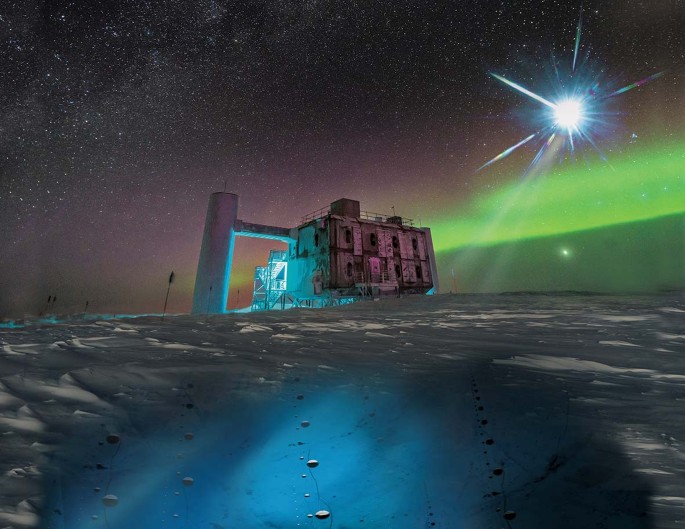
- Select a language for the TTS:
- UK English Female
- UK English Male
- US English Female
- US English Male
- Australian Female
- Australian Male
- Language selected: (auto detect) - EN
Play all audios:
Access through your institution Buy or subscribe Sunk deep into the ice of the South Pole lies a huge neutrino detector, IceCube. Completed in 2011, IceCube searches for neutrinos coming
from astrophysical sources. Because neutrinos hardly interact with the inter-stellar medium, neutrino astronomy can provide new insights into astrophysical phenomena that are not available
from electromagnetic observations. IceCube is part of the world-wide network of multi messenger astronomy instruments. IceCube data is also of interest to high-energy particle physicists
because neutrinos generated by astrophysical sources have significantly higher energies than those achievable in particle accelerators on Earth. Despite the huge challenges of working in
such a remote location, Antarctica was chosen as the site for IceCube as it offered a huge volume of pure, uniform ice. In addition, other neutrino detectors were all in the northern
hemisphere, so Antarctica provided a view of the southern sky. Over the course of seven years, 86 holes were drilled into the ice, reaching the bedrock at a depth of up to 2500 m. Into each
hole, a vertical string lined with 60 photodetectors was lowered into the ice. In total, the experiment contains 5160 extremely sensitive photodetectors, capable of detecting energies up to
the order of exaelectronvolts (1018 eV). This is a preview of subscription content, access via your institution ACCESS OPTIONS Access through your institution Access Nature and 54 other
Nature Portfolio journals Get Nature+, our best-value online-access subscription $29.99 / 30 days cancel any time Learn more Subscribe to this journal Receive 12 digital issues and online
access to articles $99.00 per year only $8.25 per issue Learn more Buy this article * Purchase on SpringerLink * Instant access to full article PDF Buy now Prices may be subject to local
taxes which are calculated during checkout ADDITIONAL ACCESS OPTIONS: * Log in * Learn about institutional subscriptions * Read our FAQs * Contact customer support REFERENCES RELATED
ARTICLES * IceCube Collaboration, Aartsen, M. G. et al. Evidence for High-Energy Extraterrestrial Neutrinos at the IceCube Detector. _Science_ 342, 1242856 (2013) Article Google Scholar *
The IceCube, Fermi-LAT, MAGIC, AGILE, ASAS-SN, HAWC, H.E.S.S, INTEGRAL, Kanata, Kiso, Kapteyn, Liverpool telescope, Subaru, Swift/NuSTAR, VERITAS, and VLA/17B-403 teams. Multimessenger
observations of a flaring blazar coincident with high-energy neutrino IceCube-170922A. _Science_ 361, eaat1378 (2018) Article ADS Google Scholar * The IceCube Collaboration., Aartsen, M.
G. & Abbasi, R. et al. Detection of a particle shower at the Glashow resonance with IceCube. _Nature_ 591, 220–224 (2021) Article ADS Google Scholar Download references AUTHOR
INFORMATION AUTHORS AND AFFILIATIONS * Nature Reviews Physics https://www.nature.com/natrevphys/ Ankita Anirban Authors * Ankita Anirban View author publications You can also search for this
author inPubMed Google Scholar CORRESPONDING AUTHOR Correspondence to Ankita Anirban. RIGHTS AND PERMISSIONS Reprints and permissions ABOUT THIS ARTICLE CITE THIS ARTICLE Anirban, A. Ten
years of IceCube. _Nat Rev Phys_ 3, 307 (2021). https://doi.org/10.1038/s42254-021-00315-4 Download citation * Published: 14 April 2021 * Issue Date: May 2021 * DOI:
https://doi.org/10.1038/s42254-021-00315-4 SHARE THIS ARTICLE Anyone you share the following link with will be able to read this content: Get shareable link Sorry, a shareable link is not
currently available for this article. Copy to clipboard Provided by the Springer Nature SharedIt content-sharing initiative




